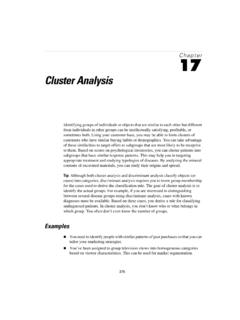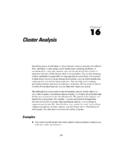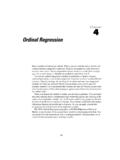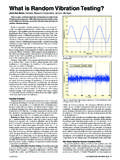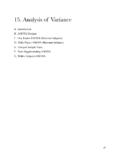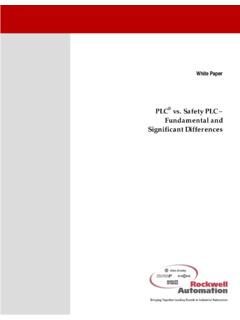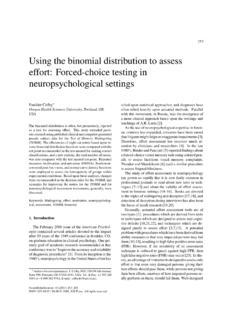Transcription of Testing a Hypothesis about Two Independent …
1 269 1314 Testing a Hypothesis about Two Independent MeansHow can you test the null Hypothesis that two population means are equal, based on the results observed in two Independent samples? Why can t you use a one-sample t test? What assumptions are needed for the two- Independent -samples t test? Can you prove that the null Hypothesis is true? What is power, and why is it important?All flavors of social scientists are agonizing over the effects of Internetuse. One day you re told that e-mail helps you to connect to friends andfamily and makes you a happy, social person. Several days later the newsis bad.
2 Internet users don t spend time with their families, they redepressed and addicted. Evaluating the effects of the Internet on societywill, no doubt, keep faculty and graduate students occupied for manyyears to come. (Note that medical researchers still argue over whetherchocolate, cheese, and red wine, which have been consumed for centu-ries, are good or bad for you, in moderation of course.) You, too, can participate in Internet research by using the GeneralSocial Survey to test hypotheses about differences between those whouse the Internet and those who don t.
3 You already found that Internetusers appear to be better educated and younger. In this chapter, you lltest hypotheses about television-viewing behavior in Internet users andnon-users. You ll determine whether Internet use is related to hours oftelevision ll learn how to test whether two population means are equal,based on the results observed in two Independent samples one fromeach of the populations of interest. The statistical technique you ll use iscalled the two- Independent -samples t test. You can use the two-indepen-dent-samples t test to see if in the population men and women have the270 Chapter 14 same scores on a test of physical dexterity or if two treatments for highcholesterol result in the same mean cholesterol levels.
4 'This chapter uses the data file. For instructions on how toobtain the Independent -samples t test output shown in this chapter, see How to Obtain an Independent -Samples T Test on p. Television ViewingThe first step of any statistical analysis is to examine the data want to make sure that the values are plausible. You also want toexamine the shape of the distribution so that you can select an appro-priate statistical test for Testing hypotheses of interest. Figure histograms of the number of hours of television viewing per dayreported by Internet users and non-users.
5 (The GSS question is, On theaverage day, about how many hours do you personally watch televi-sion? .) You see that both distributions have a tail toward large values,indicating that there are people who report watching television for manyhours each day. Some of these values raise statistical concerns as well asconcerns about the sanity of some of our fellow citizens. There are peoplewho report watching television for 24 hours a day. You know that isn tpossible. It may be that people are reporting how many hours they havethe television turned on. Watch television is not a very well-definedterm.
6 If you have the television on while you re doing homework, are youstudying or watching television? It s probably the case that you re doingsome of both. When you tally the number of hours you ve spent studyingfor a test, the television time will probably be counted as study time. Toan interviewer from the General Social Survey, you might more honestlyreport it as television a Hypothesis about Two Independent Means271We ll proceed with our analyses, assuming that the reported televisiontimes are correct. However, we will examine the impact of the outlyingpoints on the results of the analyses.
7 If our conclusions change when thesuspect data values are removed, we ll have to consider other approachesto analyzing the the descriptive statistics in Figure , you see that Internetusers reported an average of hours of television viewing per daycompared to hours for those who don t use the Internet. Internetusers, on average, report watching television for about an hour a day lessthan those who don t use the Internet. Notice that the 5% trimmedmeans, which are calculated by removing the top and bottom 5% of theFigure Histograms of hours spent watching televisionIn the Explore dialog box, select tvhours as the dependent variable and usenet as the factor variable.
8 In the Plots dialog box, select per day watching TV120100806040200 FrequencyMean = Dev. = = 473 Don t use Internet1815129630 Hours per day watching TV1251007550250 FrequencyMean = Dev. = = 413 Internet users272 Chapter 14 values, are hours less for both groups than the arithmetic those very large values makes both means smaller. You know that even if the average hours of television viewing in thepopulation are the same for Internet users and non-users, the samplemeans will not be equal. Different samples from the same populationresult in different sample means and standard deviations.
9 To determine ifobserved sample differences among groups might reflect differences in thepopulation, instead of just sample-to-sample variability, you need todetermine if the observed sample means are unusual if the populationFigure Descriptive statistics for hours spent watching televisionWhy is the number of Internet users and non-users much smallerthan in earlier chapters? The General Social Survey doesn t ask all?people all questions. Everyone is asked core questions ( about age, educa-tion, and income, for example) and a certain number of specializedquestions.
10 This is done so that the interviews don t become unbearablylong. Only two-thirds of the sample were asked questions about televi-sion viewing. The people who are asked any particular question are stilla random sample from the United States adult population. Testing a Hypothesis about Two Independent Means273means are equal. You need to figure out how often you would see a differ-ence of at least hours between the two Independent groups of Internetusers and non-users when there is no difference between the two groupsin the you have means from two Independent groups, you can t use theone-sample t test to test the null Hypothesis that two population meansare equal.
